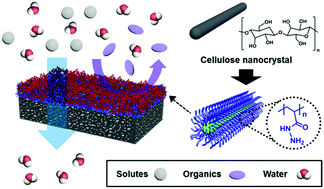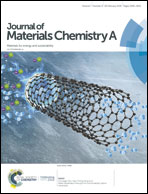Cellulose nanocrystal-assembled reverse osmosis membranes with high rejection performance and excellent antifouling†
Abstract
The state-of-the-art thin film composite (TFC) reverse osmosis (RO) membranes suffer from unsatisfactory boron rejection and a high fouling propensity, which reduce the process efficiency, necessitating the development of a new membrane chemistry using advanced materials. In this study, we designed a core–shell structured, poly(acryloyl hydrazide)-grafted cellulose nanocrystal (CNC-PAH) as a new building material that can be assembled into a RO membrane with high selectivity and low fouling via the layered interfacial polymerization (LIP) technique. The LIP method allowed for the uniform, dense and strong deposition of the CNC-PAH particles on a support. The high density reactive functional groups provided by the densely-packed CNC-PAH enabled the formation of a highly cross-linked and permselective network, leading to the fabrication of a TFC membrane with water permeance and NaCl rejection comparable to those of the commercial RO membrane. Importantly, the boron capturing ability endowed by the abundant hydroxyl and amine groups remaining in CNC-PAH improved boron rejection of the membrane, which exceeded that of the commercial membrane. Furthermore, along with the higher surface smoothness of the CNC-PAH-assembled membrane, its higher hydrophilicity and greater negative surface charge remarkably enhanced organic fouling resistance compared to the commercial membrane.



 Please wait while we load your content...
Please wait while we load your content...